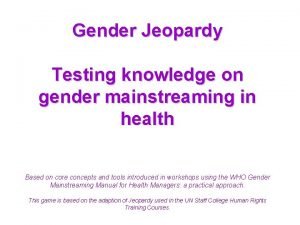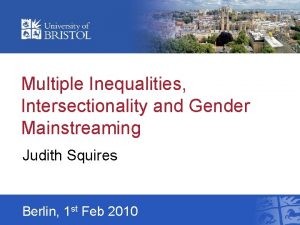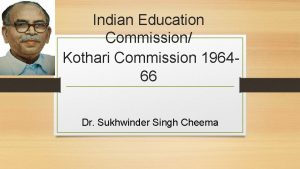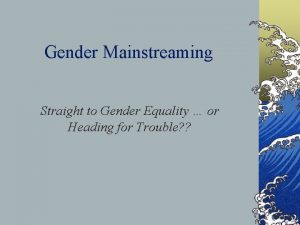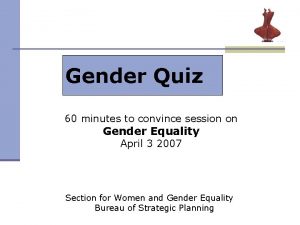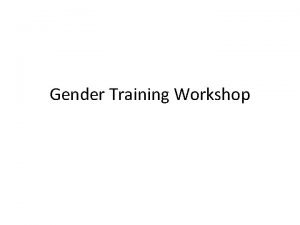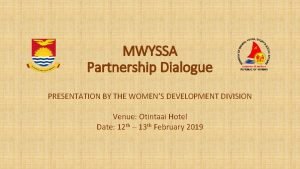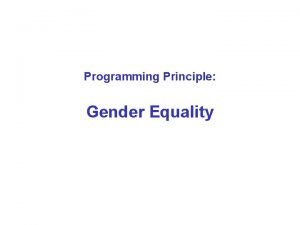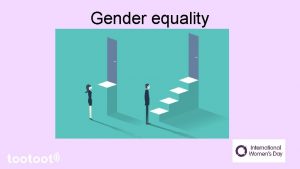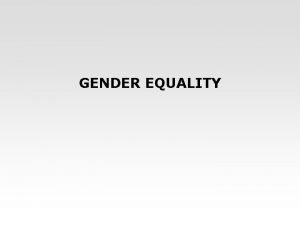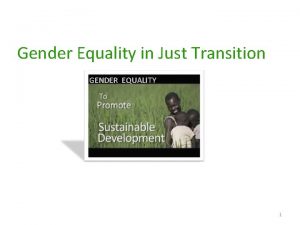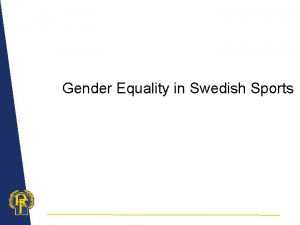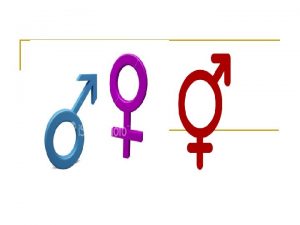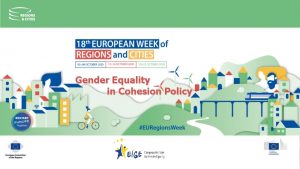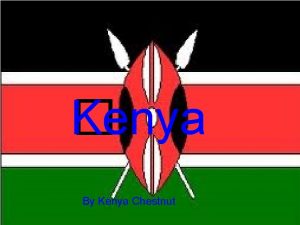Forest Landscape Restoration in Kenya Addressing Gender Equality












- Slides: 12

Forest Landscape Restoration in Kenya Addressing Gender Equality Markus Ihalainen - CIFOR

BACKGROUND • As part of the Bonn Challenge, the Kenyan government has pledged to restore 5. 1 m ha by 2030 • To move from pledge to implementation, the Kenyan government decided to develop a National FLR Strategy – Process led by Kenyan Government and WRI; CIFOR asked to support by conducting ‘gender assessment’ – Based on pre-defined landscapes (forest, cropland, rangeland) – Prioritization of restoration options in different landscapes to be informed by cost-benefit analysis

COST-BENEFIT ANALYSES AND WHY THEY MATTER • Different agendas, objectives, priorities and approaches: synergies and trade-offs between different landscape functions, as well as environmental and socioeconomic objectives • Key steps: 1) define restoration transition (e. g. degraded cropland => agroforestry); 2) identify impacts to stakeholders (costs and benefits); 3) monetize and aggregate all impacts, discount long-term impacts; 4) make policy recommendation (option with largest net present value) (Verdone et al 2015) • “Accounting for the impacts of restoration activities provides an opportunity to determine if their current designs warrant investments … [and] offers an opportunity to adjust restoration models so that investors see restoration as an investible opportunity. ” (Verdone 2015, 4)

IUCN (forthcoming)

THEORETICAL FRAMEWORK Sijapati Basnett, B. , Elias, M. , Ihalainen, M. , Paez-Valencia, A. M. (2017): Gender matters in Forest Landscape Restoration. A framework for design and evaluation. CIFOR, Indonesia. • Gender roles and inequalities influence women and men’s restoration priorities, contributions as well as the distribution of costs and benefits – Who incurs what costs, who has access to what benefits? • Equitable participation and benefits can be critical to effective and sustainable restoration Research questions: • How and to what extent are women and men participating in and benefiting from FLR initiatives? • How do different types of FLR initiatives across different landscapes (forests, rangelands, croplands) impact women and men’s rights and wellbeing? • What are some of the key mechanisms and underlying factors causing differentiated and/or unequal participation, benefits and impacts between and among women and men?

STUDY SITES AND METHODOLOGY Case studies: • Rangeland: Naibunga Conservancy (Laikipia County), implemented by Northern Rangeland Trust and community. – Rehabilitation (zoning, reseeding, conservation) • Cropland: Mwala (Machakos County), implemented by World. VIsion – Agroforestry, silviculture • Forestland: Geta forest (Nyandarua County), PELIS program implemented by KFS – Reforestation (plantations) • Forestland: Kikuyu escarpment forest (Lari county), PELIS + conservation and livelihood projects implemented by KENVO. – Conservation, reforestation (plantations) Methods • Literature and policy review • FGDs and key informant interviews Site Naibunga Project staff Project Officer (NRT) Key informant Chairman of Naibunga Conservancy, male FGDs 8 men; 10 women Lari Project Officer (KENVO) CFA chairperson, male 4 men; 4 women Nyandarua District Forest Officer (KFS) CFA chairperson, male 9 men; 6 women Mwala Project Officer (World. Vision) WRUA chairperson, male 5 men; 6 women

DIFFERENTIATED COSTS AND BENEFITS Location Option Context Costs Benefits Approach Mwala Agroforestry Women provide most agricultural labor; men control land; male out-migration Financial (M/w); Labor (W) Timber (M); fruits (m/w); income from crop sales (m/w); labor (w) Engage women’s group; market support; technical and financial assistance Naibunga Rangeland rehabilitation (zoning, opuntiaremoval, grass reseeding, protection of Acacia) Pastoralist community: men raise livestock, women produce charcoal; decisionmaking vested in male leaders. Livelihood loss (w); labor (W/m) Better grazing, improved cattle income (M); casual salaries (W/m); alternative livelihood (W); firewood (w) Cattle payments paid to household head; women prioritized in casual labor; cash payments for casual work; support to women’s group Nyandarua Afforestation Public land; men own majority of private farmland around forest; genderequitable CFA (1/3 gender quota) Labor (esp tree planting) (W/m); financial (m/w) Income from crop sales (W/m); cooler climate (m/w); timber (KFS) Allow communitymembers to plant short-rotation crops on forest land while tending for trees; priority to disadvantaged groups Lari Afforestation; conservation Public and private land; men control land while women do most farming; malecontrolled CFA Labor (male outmigration; tree planting and farming) (W/m); financial Tree nurseries (m); crop sales (M/w); income from alt. livelihood initiatives (m); food security (all); timber (M/KFS) Allow communitymembers to plant short-rotation crops on forest land while tending for trees; small-scale livelihood initiatives




KEY TAKE-AWAYS • Implementation of restoration activities is heavily dependent on local people’s labor • Gender division of labor in restoration reflects pre-existing relations, norms and perceptions about women and men’s labor • Access to long-term benefits influenced by gender relations in terms of land ownership and decision-making power, often biased against women and youth • Prioritization of restoration options, CBAs need to be informed by gender analysis and inclusive consultations, recognize women as stakeholders • Various forms of short-term benefits play an important role in incentivizing and compensating for participation in restoration activities, calling attention to project/program design and delivery • Access to immediate benefits (esp. financial) can have transformational potential – However, weak monitoring of socioeconomic impacts

Thank you! cifor. org blog. cifor. org Forests. Trees. Agroforestry. org
 Flat addressing vs hierarchical addressing
Flat addressing vs hierarchical addressing Strategic gender needs and practical gender needs
Strategic gender needs and practical gender needs Slogan about discrimination
Slogan about discrimination Rhetorical questions about gender equality
Rhetorical questions about gender equality Recommendation of kothari commission on teacher education
Recommendation of kothari commission on teacher education Claudia padovani unipd
Claudia padovani unipd Gender equality definition
Gender equality definition Poetry ideas
Poetry ideas What is gender equality answer
What is gender equality answer Example of gender equality
Example of gender equality Gender equality is more than a goal in itself
Gender equality is more than a goal in itself Methodology of gender inequality
Methodology of gender inequality Formal and substantive equality
Formal and substantive equality


